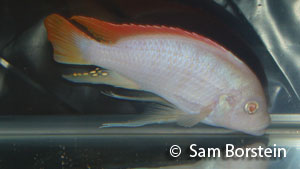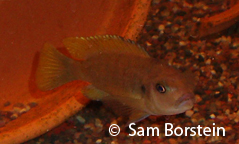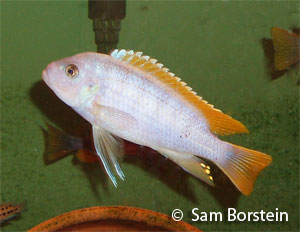Metriaclima greshakei
(Meyer & Foerster, 1984)
Red Top Ice Blue Zebra
Synonyms: Maylandia greshakei, Pseudotropheus greshakei


Above: A male Metriaclima greshakei . Photo by Sam Borstein.
Etymology:
Genus- Metri= average (Latin), clima= slope (Latin).
Species- greshakei= Named after Alfons Greshake.
Intro:
Metriaclima greshakei is a maternal-mouthbrooding, Lake Malawi zebra type that grows to about six inches. This fish was first typed by Meyer and Foerester in 1984 and is used in the debated genus Maylandia. Because the description is lacking, I've decided to use the more widely accepted genus name Metriaclima. Metriaclima greshakei's common name— the Red Top Ice Blue— is descriptive. The male's dorsal fin being a vibrant bright orange and the general body color of the fish is light blue. Females are a drab brown-orange. This fish is very closely related to Metriaclima mbenji.
Metriaclima greshakei is also available in an albino form.

Above: A albino male Metriaclima greshakei. Photo by Sam Borstein.
Distribution:
Metriaclima greshakei is most common in the rocky zones of the southeast part of Lake Malawi.
Size, Maturity, and Sexual Dimorphism:
Size: Males- 6 inches, Females- 5 inches
Maturity: 3 inches
Sexual Dimorphism: Males are larger than females and are light blue with orange fins, while females are a brownish/red. Females may have a little orange in the fins.

Above: A female Metriaclima greshakei. Photo by Sam Borstein.
Care:
Metriaclima greshakei is easy to care for. The fish is relatively aggressive and should be housed in a 75-gallon tank or larger tank with numerous hiding spots. This fish is very territorial and aggressive to conspecifics, but generally will leave other species alone. If given enough cover this fish is easily kept. Good tankmates are Victorian cichlids and Malawi haps.
Diet:
In the wild Metriaclima greshakei eats phytoplankton from the water column, but will gladly take veggie flakes, cichlid flakes and other prepared foods in the aquarium. I fed HBH graze, New Life Spectrum and Dainichi Veggie Deluxe. Like all mbuna, a significant portion of the diet should include vegetable matter. This fish can bloat if fed too much protein.
Breeding:
Metriaclima greshakei is a maternal mouthbrooder that is relatively easy to breed. Before spawning, the male brightened up so much that he was nearly a whitish/blue. The fish spawned on piece of slate in typical mbuna fashion.
After the first two spawns, the fish dropped or ate their eggs. I had heard that Metriaclima greshakei is a bad holder, which is surprising as most mbuna are reliable. Reports indicated that this fish lays about 30-50 eggs and hold for around 25 days.
I did keep these fish in with my Lipochromis sp. "Parvidens Red", a fish which you can read about in the Victorian section of my site. The Lipochromis genus are fish that are fry robbers, and obtain their food by bumping a holding females buccal cavity, and then eating the eggs she spits from the force of the hit. I saw this behavior in my tank, and when the Red Top Ice Blues where holding, the Lipochromis sp. "Parvidens Red" kept an almost vertical swimming stature and shot up at my female Metriaclima greshakei. This may be why the fish never held well.
I finally got fed up with the fish. The next time they spawned, I stripped the female after three days of ten eggs. I put the eggs in a 2-gallon, clear Rubbermaid hatching tank along with a small heater and a sponge filter. The water was extremely clean (90% new water) and cycled. After about ten days, the fry were free swimming and eating freshly hatched baby brine shrimp. They stayed in the little tub for a week until I moved them into a 10-gallon tank. The fry are easy to raise and good eaters.

Above: A male Metriaclima greshakei in breeding color. Photo by Sam Borstein.
Conclusion:
This was one of my favorite mbuna to keep. Males are stunning in color and the fish are quite lively. You may see this fish at a local pet shop, but are much more likely to find it at a local cichlid club.
References:
- IUCN. IUCN Red List of Threatened Species. <http://www.iucnredlist.org>.
- Konings, A. (2007) Malawi cichlids in their natural habitat. 4th ed., Cichlid Press, El Paso, Texas, 424 pp.
- Meyer, M. K. and W. Foerster (1984) Un nouveau Pseudotropheus du lac Malanvia vec des remarques sur le complexe Pseudlotropheus-Melanochromis (Pisces, Perciformes, Cichlidae). Revue fr. Aquariol. 10, 107-112.
